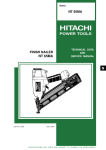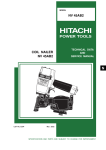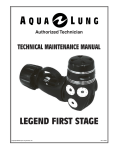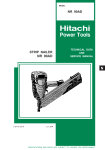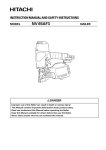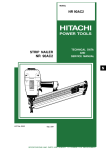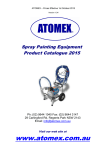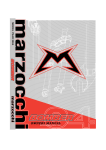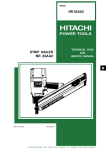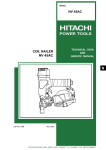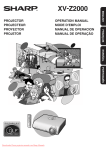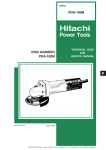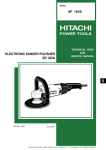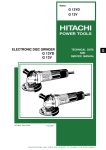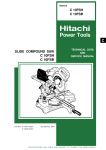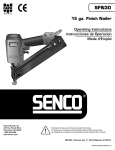Download COIL NAILER Model NV 75AG
Transcript
MODEL NV 75AG POWER TOOLS COIL NAILER NV 75AG TECHNICAL DATA AND SERVICE MANUAL N LIST No. E006 Aug. 2002 SPECIFICATIONS AND PARTS ARE SUBJECT TO CHANGE FOR IMPROVEMENT REMARK: Throughout this TECHNICAL DATA AND SERVICE MANUAL, a symbol(s) is(are) used in the place of company name(s) and model name(s) of our competitor(s). The symbol(s) utilized here is(are) as follows: Competitors Symbols Utilized R Company Name Model Name SENCO SCN60 CONTENTS Page 1. PRODUCT NAME ..................................................................................................................... 1 2. MARKETING OBJECTIVE ....................................................................................................... 1 3. APPLICATIONS ........................................................................................................................ 1 4. SELLING POINTS .................................................................................................................... 1 5. SPECIFICATIONS .................................................................................................................... 2 5-1. Specifications ........................................................................................................................... 2 5-2. Nail Selection ........................................................................................................................... 3 5-3. Nail Driving Force .................................................................................................................... 5 6. COMPARISONS WITH SIMILAR PRODUCTS ........................................................................ 6 7. PRECAUTIONS IN SALES PROMOTION ............................................................................... 7 7-1. Instruction Manual ------------------------------------------------------------------------------------------------ 7 7-2. Warning Label ------------------------------------------------------------------------------------------------------ 7 7-3. Related Laws and Regulations -------------------------------------------------------------------------------- 7 7-4. Precautions in Operation ---------------------------------------------------------------------------------------- 8 8. MECHANISM AND OPERATION PRINCIPLE ......................................................................... 9 8-1. Mechanism .............................................................................................................................. 9 8-2. Interchangeability of Parts ...................................................................................................... 11 8-3. Operation Principle ................................................................................................................ 12 9. TROUBLESHOOTING GUIDE ............................................................................................... 14 9-1. Troubleshooting and Correction ............................................................................................. 14 9-2. Possible Causes and Corrections of Air Leakage .................................................................. 19 10. DISASSEMBLY AND REASSEMBLY .................................................................................. 22 10-1. General Precautions in Disassembly and Reassembly ....................................................... 22 10-2. Disassembly and Reassembly of the Output Section .......................................................... 23 10-3. Disassembly and Reassembly of the Control Valve Section ............................................... 25 10-4. Disassembly and Reassembly of the Magazine Section ..................................................... 28 10-5. Disassembly and Reassembly of the Driving Section ......................................................... 31 10-6. Grip Rubber ......................................................................................................................... 35 11. INSPECTION AND CONFIRMATION AFTER REASSEMBLY ............................................ 36 12. STANDARD REPAIR TIME (UNIT) SCHEDULES ............................................................... 37 Assembly Diagram for NV 75AG 1. PRODUCT NAME Hitachi 75 mm (3") Coil Nailer, Model NV 75AG 2. MARKETING OBJECTIVE Nails 75 mm (3") long are most popularly used for framing work in the U.S.A. Although our current coil nailer Model NV 83A is capable of driving nails 83 mm (3-1/4") long maximum, it is heavy in weight (3.5 kg (7.7 lbs.)). C is also heavy in weight (3.6 kg (7.9 lbs.)) even though it is capable of driving nails 70 mm (2-3/4") long maximum. The newly developed 75 mm (3") coil nailer Model NV 75AG is ultra-lightweight (2.5 kg (5.5 lbs.)) and features the following: "Pop-out magazine" allows easy nail loading from the top of the magazine because the nail holder can be tilted. Driving depth is adjustable without tool. The driving section is simplified because the depth adjuster is located near the trigger. The tip of the nose is easy to see and operate. The exhaust air outlet is 360˚ adjustable without tool. Capable of driving either wire-collated or sheet-collated nails. There is a demand for a high-power nailer capable of driving larger-diameter nails from the users of the Model NV 65AH. The new Model NV 75AG can also satisfy the above demand. Please expand the sales of the new Model NV 75AG. 3. APPLICATIONS Floor and wall framing Siding, fencing, decking Wall and roof sheathing Mobile home and modular housing construction Crate and pallet construction Note: The nails of 3.3 mm (.131") dia. x 75 mm (3") length may not be driven reliably into some materials. Salespersons should instruct the customers to perform a driving test before actual use. 4. SELLING POINTS Lightweight: 2.5 kg (5.5 lbs.) Grip rubber 360˚ adjustable exhaust Tool-less depth adjustment Capable of driven both wire-collated and sheet-collated nails Easy top load pop-out magazine --- 1 --- 5. SPECIFICATIONS 5-1. Specifications NV 75AG Model Driving system Reciprocating piston type Operating pressure 5 --- 8.5 kgf/cm2 (70 --- 120 psi, 4.9 --- 8.3 bar) (Gauge pressure) Driving speed 3 pcs./sec. Weight 2.5 kg (5.5 lbs.) Dimensions (Length x height x width) 271 mm x 338 mm x 132 mm (10-11/16" x 13-5/16" x 5-3/16") Nail feed system Spiral spring Nail capacity 200 --- 300 nails (1 coil) Air consumption 1.8 ltr/cycle at 7 kgf/cm2 (0.064 ft3/cycle at 100 psi, 1.8 ltr/cycle at 6.9 bar) Air inlet 3/8 NPT thread Packaging Corrugated cardboard box Package dimensions (Length x height x width) 315 mm x 150 mm x 386 mm (12-3/8" x 5-7/8" x 15-1/4") Standard accessories Eye protector (Code No. 875769) .............................................................. 1 Hex. bar wrench for M6 screw (Code No. 944459) .................................... 1 Hex. bar wrench for M5 screw (Code No. 944458) .................................... 1 Hex. bar wrench for M4 screw (Code No. 943277) .................................... 1 Nose cap (Code No. 883106) ..................................................................... 1 Optional accessories Pneumatic tool lubricant (1 oz oil feeder) (Code No. 877153) Pneumatic tool lubricant (4 oz oil feeder) (Code No. 872042) Pneumatic tool lubricant (1 quart can) (Code No. 876212) Sequential fire parts set (Code No. 881973) Case (Code No. 883323) --- 2 --- 5-2. Nail Selection The Model NV 75AG utilizes common round-head nails collated by wire or sheet into coils from 200 to 300 pieces. Applicable nail dimensions are shown below. However, it is recommended to use genuine HITACHI nails to ensure satisfactory driving quality. CAUTION: Ensure that nails are as specified in Figs. 1, 2 and 3. Other nails will cause clogging of nails and subsequent damage to the nailer. NOTE: Aluminum nails may bend when driven into a hard workpiece. Test before use. Sheet-collated nails Min. 7.2 mm (0.283") 5.7 mm (0.224") 75 mm (3") 45 mm (1-3/4") 6 mm (0.236") Max. 45 mm (1-3/4") Min. 2.3 mm (0.090") 2.5 mm (0.099") Max. 6 mm (0.236") 57 mm (2-1/4") Wire-collated nails 2.5 mm (0.099") 3.3 mm (0.131") Fig. 1 Dimensions of nails --- 3 --- L Type A B d L1 d1 L2 D1 D2 H 2.5 --- 2.9 45 --- 65 (1-3/4 --- 2-1/2) (0.099 --- 0.113) 65 --- 75 (1-1/2 --- 3) 72 0.7 19 37.5 28 121 (2.835) (0.028) (0.748) (1.476) (1.102) (4.764) 80 3.1 --- 3.3 (3.150) (0.120 --- 0.131) Fig. 2 Dimensions of wire-collated nails L d 45 --- 57 (1-3/4 --- 2-1/4) 2.3 --- 2.5 (0.090 --- 0.099) D1 D2 H 20 118 61.5 (0.787) (4.645) (2.421) Fig. 3 Dimensions of sheet-collated nails --- 4 --- Unit: mm (inch) 5-3. Nail Driving Force Fig. 4 shows by type of wood and nail the nailer output energy provided by the supply pressure and the nailing energy required for driving the nail flush. Air pressure which exceeds the intersecting point between the nailer output energy and the required nailing energy for driving the nail allows the nail to be fully driven. For example, when driving a nail of 3.3 mm dia. x 75 mm length (0.131" x 3") into a workpiece of hemlock with the Model NV 75AG, a pressure of about 8 bar (8.2 kgf/cm2, 116 psi) allows the nailer to drive the nail flush with the wood surface. A pressure beyond this value causes the nail head to be driven below the wood surface. Fig. 4 should be used as a reference only because those values vary depending on the type of wood, moisture content, and grain of wood. Required nailing energy Nailer output energy R NV 83A Hemlock NV 75AG 3.3 x 75 mm (.131 x 3") 2.3 x 45 mm (.090 x 1-3/4") Size of nail mm (in) NV 65AH Fig. 4 Required nailing energy and nailer output energy --- 5 --- --- 6 --- 5 --- 8.5 kgf/cm2 (70 --- 120 psi) 2.1 kg (4.6 lbs.) 5 --- 8.5 kgf/cm2 (70 --- 120 psi) 2.5 kg (5.5 lbs.) Operating pressure Weight 200 --- 300 nails Nail capacity Applicable nails 2.3 mm -- 2.5 mm (0.090" -- 0.099") 45 mm -- 57 mm (1-3/4" -- 2-1/4") 2.5 mm -- 3.3 mm (0.099" -- 0.131") 45 mm -- 75 mm (1-3/4" -- 3") Length Sheet Diameter Wire Tool not required Direction change of exhaust air Collation Tool not required Driving depth adjustment mechanism Top loading (Black plastic) 1.8 ltr/cycle (0.064 ft3/cycle) Air consumption at 7 kgf/cm2 (100 psi) Magazine type (Material) 1.4 ltr/cycle (0.049 ft3/cycle) 271 mm x 338 mm x 132 mm (10-11/13" x 13-5/16" x 5-3/16") Dimensions (L x H x W) Sheet 38 mm -- 65 mm (1-1/2" -- 2-1/2") 38 mm -- 57 mm (1-1/2" -- 2-1/4") 2.3 mm -- 2.5 mm (0.090" -- 0.099") Wire Tool not required Tool not required Bottom loading (Clear plastic) 200 --- 300 nails 266 mm x 300 mm x 128 mm (10-1/2" x 11-13/16" x 5-1/16") 130 Power ratio 100 HITACHI NV 65AH Maker and model HITACHI NV 75AG 6. COMPARISONS WITH SIMILAR PRODUCTS 200 3.6 kg (7.9 lbs.) 5 --- 7.0 kgf/cm2 (70 --- 100 psi) R 2.5 mm -- 2.9 mm (0.099" -- 0.113") 50 mm -- 70 mm (2" -- 2-3/4") 50 mm -- 83 mm (2" -- 3-1/4") Wire Tool required Tool not required Top loading (Black plastic) 200 --- 350 nails 3.1 ltr/cycle (0.109 ft3/cycle) 2.5 mm -- 3.3 mm (0.099" -- 0.131") Wire None Tool required Bottom loading (Black plastic) 200 --- 300 nails 2.5 ltr/cycle (0.088 ft3/cycle) 324 mm x 318 mm x 141 mm 290 mm x 348 mm x 137 mm (11-13/32" x 13-11/16" x 5-13/32") (12-25/32" x 12-17/32" x 5-9/16") 200 3.5 kg (7.7 lbs.) 5 --- 8.5 kgf/cm2 (70 --- 120 psi) HITACHI NV 83A 7. PRECAUTIONS IN SALES PROMOTION In the interest of promoting the safest and most efficient use of the Model NV 75AG Nailer by all of our customers, it is very important that at the time of sale the salesperson carefully ensures that the buyer seriously recognizes the importance of the contents of the Instruction Manual, and fully understands the meaning of the precautions listed on the Warning Label attached to each tool. 7-1. Instruction Manual Although every effort is made in each step of design, manufacture, and inspection to provide protection against safety hazards, the dangers inherent in the use of any pneumatic tool cannot be completely eliminated. Accordingly, general precautions and suggestions for use of pneumatic tools, and specific precautions and suggestions for the use of the pneumatic nailer are listed in the Instruction Manual to enhance the safe and efficient use of the tool by the customer. Salespersons must be thoroughly familiar with the contents of the Instruction Manual to be able to offer appropriate guidance to the customers during sales promotion. 7-2. Warning Label Each Model NV 75AG unit is provided with a Warning Label (illustrated below) which lists basic safety precautions in its use. Carefully ensure that the customers fully understand and follow these precautions before using the tool. 7-3. Related Laws and Regulations As nailers and staplers are designed to instantaneously drive nails and staples, there is an ever-present danger of misfiring and subsequent possible serious injury. Accordingly, close attention in handling is absolutely necessary at all times. Carefully ensure that the customer is fully aware of the precautions listed in the Instruction Manual provided with each unit. While there are no specific safety regulations, there are related items in various general safety regulations with which the salespersons should be familiar in order to advise the customer properly. Please check your national and/or local regulations for applicable items. Some applicable items are outlined below. The U.S.A: OSHA 1926.102 Eye and Face Protection 1926.302 Power-Operated Hand Tools ANSI SNT-101-1993 Portable, Compressed-Air-Actuated, Fastener Driving Tools-Safety Requirements for --- 7 --- 7-4. Precautions in Operation (1) Pay special attention to the pressure, capacity and piping of the air compressor in order to keep the air pressure supplied to the Model NV 75AG within the range from 5 kgf/cm2 (70 psi, 4.9 bar) to 8.5 kgf/cm2 (120 psi, 8.3 bar). Otherwise, ill effect may be given to the performance, service life and safety of the Model NV 75AG. (Be sure to install a regulator when using a high-pressure air compressor whose set pressure is 10 kgf/cm2 (140 psi, 9.8 bar) or more. In this case, adjust the air pressure at 8.5 kgf/cm2 (120 psi, 8.3 bar) or less.) (2) If dust in the compressed air settles on the sliding portion, the Model NV 75AG will not operate properly. Lubrication is effective to remove dust and also to prolong the service life of the Model NV 75AG keeping good performance. It is recommended to lubricate the Model NV 75AG daily. Supply 5-10 drops of lubricant into the air plug on the Model NV 75AG. When not in use for an extended period, supply lubricant and perform idle driving two or three times to lubricate the inside, then apply a thin coat of the lubricant to the steel parts to avoid rusting. Usable lubricant is specified in the following table. Please recommend the customers to use Hitachi nailer/ tacker oil. Type of oil Hitachi Pneumatic Tool Lubricant Brand or product name Shell sliding oil, Tonna S32 (Old Tonna T32); Code No. 877153 (1 oz. oil feeder) Code No. 874042 (4 oz. oil feeder) Code No. 876212 (1L (1 quart) can) (3) Be sure to drain the tank of the compressor securely to prevent deteriorated performance or malfunction of the Model NV 75AG due to rusting. (4) Instruct the customers (especially the heavy users) to perform inspection and maintenance securely. --- 8 --- 8. MECHANISM AND OPERATION PRINCIPLE 8-1. Mechanism As illustrated in Fig. 7, the Model NV 75AG can be generally divided into four sections: Output section, control valve section, driving section and magazine section. The parts of the output section and the control valve section are the same as those of the Model NR 65AK to allow the use of nails 75 mm (3") long, though the basic construction is the same as the Model NV 65AH. The parts of the driving section and the magazine section have been newly designed. Primary differences from the Model NV 65AH are described below. Output section ................... To make it powerful, the output section is common to the Model NR 65AK except the following: Body: There is no interchangeability with the Model NR 65AK since the Model NV 75AG has an air passage to feed nails. The handle is equipped with the grip rubber (rubber-ring type) instead of the grip tape. (Note that the repair part is the conventional grip tape because the grip rubber cannot be replaced by hand.) Cylinder: Newly designed. Piston: Newly designed. Dust filter: Dust filter is provided between the air inlet cap and the body to prevent dust from entering the inside (common to the Model NR 90AC2). Gasket (B): The shape is changed to install the dust filter (common to the Model NR 90AC2). Control valve section .......... The control valve section is common to the Model NR 65AK except the following: Plunger spring: Common to the Model NV 65AH. Trigger: Newly designed. Driving depth adjuster: Located near the trigger to simplify the nose unit. The tip of the nose is easy to see and operate. Driving section and magazine section .............The parts of the driving section and the magazine section have been newly designed. --- 9 --- Plunger Spring [58] Valve Piston (B) [57] Valve Bushing (B) [53] Top Cover [3] Exhaust vent Exhaust Cover [5] Plunger (A) [59] Valve Bushing (A) [61] Head Valve (A) [10] Output section Control valve section Control valve section Accumulator Trigger [39] Body [18] Piston (H) (Driver blade) [17] Grip rubber Dust Filter [33] Cylinder [15] Cap [34] Adjuster [44] Piston Bumper [20] Nose [22] Driving section Feeder [28] Magazine Cover (A) [78] Guide Lock [87] Nail Holder [81] Magazine (A) [75] n Nail Guide [89] ectio ne s i z a Mag Pushing Lever (A) [31] Cover [95] Section A - A Nail Guide [89] Feeder [28] Feeder Piston [64] Feed Spring [65] Fig. 5 Construction --- 10 --- 8-2. Interchangeability of Parts The driving section and the magazine section of the Model NV 75AG have been newly designed and there is no interchangeability with those of the Model NR 65AK. Although most parts of the output section and the control valve section of the Model NV 75AG are interchangeable with those of the Model NR 65AK, there is no interchangeability for the parts shown in the table below. Part Body [18] Dust Filter [33] Gasket (B) [32] NV 75AG NR 65AK Dust Filter [33] Gasket (B) [32] Gasket (B) Grip Tape (A) Grip rubber Air passage hole to feed nails (3 mm dia.) A A Viewed from "A" Viewed from "A" Cylinder [15] Upper end surface of the cylinder Upper end surface of the cylinder Bore diameter is concaved. Plunger Spring [58] Color: Black Color: Silver Plunger (A) Plunger (A) Trigger [39] Color: Yellow --- 11 --- Color: Black 8-3. Operation Principle (1) Prior to nailing (see Fig. 6) 1. When compressed air is supplied to the main body, Head valve spring it fills the accumulator (see diagram). Air passage (A) Air supply vent Head valve 2. At the same time, the compressed air flows into the Accumulator valve piston lower chamber of the control valve Cylinder section, and pushes up the valve piston. Also, the compressed air flows from the air supply vent, Valve piston (B) Control valve section through air passage (A), and into the head valve upper chamber where it simultaneously pushes down the head valve and the head valve spring to seal the upper surface of the head valve and the cylinder. Pushing lever (A) (2) During nailing (I) (see Fig. 7) 1. When plunger (A) is pushed up by operating both Fig. 6 Prior to nailing the pushing lever and trigger (A), the compressed air in the valve piston lower chamber is exhausted from the lower part of plunger (A). Then, the valve piston is pushed down by the compressed air from the accumulator so that it shuts off the air supply vent and releases the exhaust valve. Exhaust cover Head valve spring Head valve 2. When the exhaust valve opens, the compressed air Air passage (A) Air supply vent Exhaust valve Accumulator Cylinder [Return air chamber] Pushing lever (A) the atmosphere through air passage (A). 3. The air pressure applied against the lower surface Cylinder hole Piston Air passage (B) in the head valve upper chamber is exhausted into of the head valve soon exceeds the force of the Valve piston Plunger (A) Trigger (A) Pushing lever (B) Nail feeder section Feed spring Feeder Feed piston head valve spring, and pushes the head valve up. The head valve is pushed fully upward by the compressed air, and seals the upper surface of the exhaust cover and the head valve. 4. When the head valve is pushed up, the compressed air flows rapidly into the cylinder and pushes down the piston to drive a nail. At this time, Fig. 7 During nailing (I) the compressed air flows through the cylinder hole, into the return air chamber, through air passage (B), and into the chamber at the left side of the feed piston in the nail feeder section. When the air pressure exceeds the force of the feed spring, the feeder moves to the right. --- 12 --- (3) During nailing (II) (see Fig. 8) 1. When the piston moves down inside the cylinder, the air below the piston flows through air passage (C) under the cylinder and is accumulated in the Cylinder return air chamber together with the compressed air Cylinder hole flowing through the cylinder hole. [Return air chamber] Piston Air passage (C) 2. When the compressed air in the left chamber of the feed piston moves the feed piston fully to the right, the nail feeder (feed pawl) engages the next nail. Feed piston Nail feeder (4) After nailing (see Fig. 9) 1. When the trigger is released, the plunger goes down, the air supply vent opens, the valve piston Fig. 8 During nailing (II) goes up, and the compressed air in the accumulator passes through air passage (A) into the head valve upper chamber. The head valve is then pushed down by the head valve spring and the air pressure against the upper surface of the head valve. At the same time, the exhaust valve opens and the upper chamber of the cylinder is opened to the atmosphere. Head valve spring Air passage (A) Head valve Air supply vent [Accumulator] 2. When the head valve seals the upper surface of the cylinder, the compressed air accumulated in the return air chamber passes through air passage (C), Cylinder presses on the lower surface of the piston, and Piston [Return air chamber] Valve piston Plunger (A) Trigger Air passage (C) forces the piston to return upward to its original position. Also, the compressed air above the piston is exhausted through the head valve hole. 3. The compressed air accumulated in the left chamber of the feed piston passes through air Feed spring Feed piston passage (B), goes into the return air chamber, and is then exhausted through the nose hole. The feed Nail feeder piston is then moved to the left by the force of the Fig. 9 During return feed spring, and the feed pawl feeds the next nail into the ejection port. This completes one full nailing cycle. --- 13 --- 9. TROUBLESHOOTING GUIDE 9-1. Troubleshooting and Correction Problem 1) Nails cannot be driven. ( Possible cause : Most-common cause) <Nails> Magazine is not loaded with specified genuine nails. Magazine is loaded with abnormal nails (bent nails, too large or too small nail heads, abnormal collation, others). Nails or link pieces are jammed. Link pieces are deformed or broken. <Driving section: Nose, feeder, feed piston, etc.> Sliding resistance of the feed piston is too high. Nail guide face of the nose is abnormal (deformed, burrs or damaged). Feed spring or feeder spring is abnormal (damaged or fatigued). Feeder is abnormal (damaged or worn). Inspection method Remedy Check that the magazine is correctly loaded with specified nails. Use specified nails. Remove the abnormal nails and load the nailer with proper nails. Remove the feed piston and check the feed piston sliding surface of the nose. Apply grease to the sliding surface. Polish the scratched portion with sandpaper. Replace the parts. Check that the driving section is not abnormal (burrs, deformed, damaged or worn). Deburr the nail guide face. Correct the deformed part. Replace the abnormal parts. Nails are not correctly loaded in the groove of the nose. Check that nails are correctly loaded in the groove of the nose. Load nails in the correct position in the nose. Dust sticks to the feeder sliding portion of the nose, or lubrication is needed. Open the nail guide and perform idle driving to check the feeder's operation. Remove dust and then lubricate the sliding surface. Adjust the air pressure to 5 --- 8.5 kgf/cm2 (4.9 --- 8.3 bar, 70 --- 120 psi). Air pressure is too low. Air passage is clogged with broken pieces of piston bumper, etc. Remove foreign matter. Replace the piston bumper with new one. Body ••• Remove foreign matter in the return air chamber. Nose ••• Remove foreign matter in the air passage and the feed piston chamber. Feed piston chamber contains foreign matter such as broken pieces of piston bumper, etc. --- 14 --- Problem 1) Nails cannot be driven. (continued) ( Possible cause : Most-common cause) Inspection method Remedy Air leaks from the gap between the body and the nose. Tighten screws and check the O-rings. O-rings are worn or deformed. Replace the O-rings. O-rings need lubrication. Apply grease or lubricate. <Nail guide section> Nail guide face is abnormal (deformed, burrs or damaged). Dust sticks to the inside of the nail guide groove, or lubrication is needed. Check that the nail guide is not abnormal (worn, deformed, damaged, etc.). Correct or replace the parts. Check the operation of nail stopper (A) and nail stopper (B). Rremove dust and then lubricate. Spring is abnormal (missing, damaged or fatigued). The claw ridge section of the nail stopper is abnormal (damaged, worn or burrs). <Magazine section> <Push lever> Magazine Push lever <Output section: piston, driver blade, etc.> Air pressure is too low. Replace the abnormal parts. Check that a nail does not catch on another nail in the magazine. Check that a nail does not catch on some part of the magazine. Check the height of the nail holder. Collate the nails correctly and reload the nailer with them. Remove burrs or deformed part. Replace the parts. Adjust the height of the nail holder correctly. Check the operation of the push lever. Correct or replace the parts. Open the nail guide and perform idle driving to check that the driver blade is returned. Adjust the air pressure to 5 --- 8.5 kgf/cm2 (4.9 --- 8.3 bar, 70 --- 120 psi). Piston O-ring is abnormal (worn or damaged). Replace the piston O-ring. Piston bumper is abnormal. Replace the piston bumper. O-ring in the cylinder is abnormal (removed, deformed or damaged). Reassemble or replace the parts. Driver blade is abnormal (deformed, burrs or damaged). Correct or replace the part. --- 15 --- Problem 1) Nails cannot be driven. (continued) ( Possible cause : Most-common cause) Inspection method Cylinder inside surface is abnormal (packed with dust, or worn). Check that nails can be driven at 5 kgf/cm2 (4.9 bar, 70 psi). Remove dust and then lubricate. Replace the part. Head valve sliding surface is abnormal (seized or damaged, or lubrication is needed). Perform idle driving to check the driving operation. Replace the part. Apply grease. Head valve spring is abnormal (fatigued or damaged). Perform idle driving to check that the driver blade is not held in the down position. Replace the part. <Control valve section> Plunger (A), valve piston (B), valve bushing (A) or valve bushing (B) is abnormal (seized or damaged). Replace the abnormal part. Apply grease. Check that the adjuster is not raised too high. Turn the adjuster lower (lower the pressure). See item 1). See item 1). Driver blade is worn. Check that the driver blade tip is not abnormally worn. Replace the part. Workpiece is too hard. Check if a nail is bent even when driven into soft wood. Nailer cannot be used because the material is beyond its applicable range. Adjuster is incorrectly set. Turn the adjuster to the lowest position and then drive nails. Set the adjuster to the optimum position. Adjuster is raised too high for short nails. Nails are not completely fed into the injection port. Unspecified nails are used. 3) Nails cannot be driven into the workpiece completely: the heads cannot be made flush. Replace the abnormal part. Disassemble the control valve section and check the O-rings. O-rings or sliding surface are worn or needs lubrication. 2) Nails are driven but bent. Remedy Air pressure is too low. Workpiece is too hard. Adjust the air pressure to 5 --- 8.5 kgf/cm2 (4.9 --- 8.3 bar, 70 --- 120 psi). Check if a nail is bent even when driven into soft wood. --- 16 --- Nailer cannot be used because the material is beyond its applicable range. Problem 3) Nails cannot be driven into the workpiece completely: the heads cannot be made flush. (continued) ( Possible cause : Most-common cause) Remedy Driver blade is worn. Perform idle driving to check the driver blade is projected from the nose tip. Replace the part. Piston O-ring is abnormal (worn or damaged). Disassemble the output section and check the piston ring and the inside of the cylinder for abnormality. Replace the abnormal part. Check the sliding surface for abnormality and lubrication. Replace the abnormal part. Apply grease. Check if the specified nails are used. Check the nails as follows. Use specified nails. Remove the abnormal nails and load the nailer with proper nails. Cylinder inside surface is abnormal (worn or rough). Head valve sliding surface is abnormal (seized or damaged, or lubrication is needed). 4) Nails jam. Inspection method <Nails> Unspecified nails are used. Abnormal nails are mixed. Nail heads are too large or too small. [Wire-collated nails] Collating wires are abnormal (broken, welding failed, deformed or welding position failed). Collating wires are deformed (deformed in collation angle or collation pitch). [Wire-collated nails] [Wire-collated nails] Type A B D d Unit: mm (inch) L2 L1 2.5 (0.099) 19 37.5 6 --- 7.2 (0.236 --- 0.283) 3.3 (0.748) (1.476) (0.131) [Sheet-collated nails] Collating sheets are abnormal (deformed or broken). Nails are removed from the sheets. [Sheet-collated nails] [Sheet-collated nails] Unit: mm (inch) D d 5.7 --- 6.0 2.3 --- 2.5 (0.224 --- 0.236) (0.090 --- 0.099) --- 17 --- Problem 4) Nails jam. (continued) ( Possible cause : Most-common cause) Inspection method Remedy <Body: Nail feeding is incomplete.> Feeder is worn and the sliding section is abnormal. Nail guide face of the nose or the sliding section of the feeder is abnormal (deformed, burrs or damaged). Feed spring or feeder spring is abnormal (damaged, fatigued or removed). Open the nail guide and check the position of the feeder claw. Replace the abnormal part. <Body: Nail guide section> Nail guide section is abnormal. See item "1) Nail guide section". See item "1) Nail guide section". <Driver blade is not returned completely.> See item "1) Output section: piston, driver blade, etc.". Perform idle or actual driving to check if the driver blade is returned completely. See item "1) Output section: piston, driver blade, etc.". Air pressure is too high. Nails may be jammed if driven at a high pressure and high speed. Check pressure and driving speed. --- 18 --- Adjust the air pressure to 5 --- 8.5 kgf/cm2 (4.9 --- 8.3 bar, 70 --- 120 psi). 9-2. Possible Causes and Corrections of Air Leakage Air leakage repair location Repair procedure (1) Check the points of the following parts marked by an asterisk for abnormal condition. (2) Next, check the seal parts (marked with a double circle) for wear, flaws or damage. (3) And then, check other places. b (A) a (H) (B) c d e (F) (G) (C) Nail feeder section Control valve section g f h (E) (D) --- 19 --- (G) (F) Cause Air leakage portion When the Trigger is turned off When the Trigger is turned on (A) Exhaust port Abnormality in Head Valve (A) [10] and Cylinder [15] [Wear and deformation of the sealed face of the (b) section] Abnormality in Head Valve O-ring (P-22) [9] or wear, deformation and/ or breakage of Head Valve (A) [10] Abnormality (damage) in the Exhaust Cover [5] Abnormality in Head Valve (A) [10] [Wear, deformation and/or breakage of the section (a)] * Abnormality in the inner face [the section (a)] in the Exhaust Cover [5] [Deformation and dust clogging in the section (a)] (B) Exhaust cover Looseness of the Hex. Socket Hd. Bolt M5 x 35 [4] Damage of Gasket (B) [6] Abnormality in the sealed face of the Body [18], the Exhaust Cover [5] and the Cylinder [15] Looseness of the Nylock High Tension Bolt M6 x 20 [23] Scratched and/or the broken O-ring (P-4) [21] Abnormality in the sealed faces of the Body [18] and the Nose [22] (C) Nose 1 (Feed piston passage) (D) Nose 2 * Abnormality (breakage and/or scratches) in O-Ring (S-70) [11] of the Cylinder Plate [12] Abnormality in the sealing faces [the sections (c) and/or (d)] of the Cylinder Plate [12], Body [18] and/or the Cylinder [15] Abnormality (wear, breakage and/or scratches) in O-ring (P-21) [63] of the Feed Piston [64], or the wear and/or deformation of the Nose [22] on the sliding face Abnormality (wear, breakage and/or scratches) in O-ring (P-9) [62] of the Nose [22], or wear, deformation and/or scratches of the Feed Piston [64] on the sliding face (E) Feed piston (F) Control valve 1 Abnormality [deformation, crack and/or damage of the sections (e) and (f)] in the Piston Bumper [20] Deformation of Piston (H) [17] (The deformation of driver blade abnormality in sealed faces) The deformation of the face (f) of the Body [18] Abnormality (wear, deformation, breakage and/or scratches) in O-Ring (S-46) [13] Abnormality (wear, breakage and/or scratches) in O-ring (S-4) [48] of Valve Piston (B) [57] Abnormality (wear, breakage and/or scratches) in O-ring (I.D 8.8) [55] (lower side) of Valve Piston (B) [57] Abnormality (breakage and/or scratches) in O-ring (S-18) [54] of Valve Bushing (B) [53] * Abnormality in the inner face [the section (h)] of the valve chamber of the Body [18] --- 20 --- Abnormality (wear, breakage and/or scratches) in O-ring (I.D 8.8) [55] (upper side) of Valve Piston (B) [57] Abnormality (breakage and/or scratches) in Head Valve O-ring (I.D 16.8) [52] of Valve Bushing (B) [53] * Abnormality in the upper face [the section (g)] of the valve chamber of the Body [18] Cause Air leakage portion When the Trigger is turned off When the Trigger is turned on (G) Control valve 2 Abnormality (wear, breakage and/or scratches) in O-ring (I.D 1.8) [60] of Plunger (A) [59] Abnormality (deformation and/or scratches of the sliding face of Plunger (A) [59] in Valve Bushing (A) [61] Abnormality (wear, breakage and/or scratches) in O-ring (I.D 11) [56] in the inside of Valve Piston (B) [57] Abnormality (deformation and/or scratches of the sliding face of Plunger (A) [59] in Valve Piston (B) [57] (H) Cap Loosen Hex. Socket Hd. Bolt M5 x 16 [35]. Broken Gasket (B) [32] Defective seal surface of the Body [18] or Cap [34] --- 21 --- 10. DISASSEMBLY AND REASSEMBLY The items particularly necessary for disassembly and reassembly are described below. The [Bold] numbers in the descriptions below correspond to the item numbers in the Parts List and exploded assembly diagram. [CAUTION] Before disassembly or reassembly, be sure to disconnect the air hose from the nailer (with your finger released from the trigger) to exhaust all the compressed air and remove all nails. 10-1. General Precautions in Disassembly and Reassembly Apply grease (Nippeco SEP-3A, Code No. 930035) to the O-rings and O-rings' sliding portions. When installing the O-rings, be careful not to damage the O-rings and prevent dirt entry. Oil required: Hitachi pneumatic tool lubricant 1 oz (30 cc) Oil feeder (Code No. 877153) 4 oz (120 cc) Oil feeder (Code No. 874042) 1 quart (1 ltr) Can (Code No. 876212) If Gasket (B) [6] is damaged, replace it and check that no air is leaking. Be especially careful to prevent the entry of foreign particles into the control valve section. Tightening torque for each part Tightening torque N•m (kgf•cm, ft-lbs) Bolt, screw and cap Nylock High Tension Bolt M6 x 20 ................................. [23] 16.2 1.5 (165 15, 11.9 1.1) Hex. Socket Hd. Bolt M6 x 12 ....................................... [1] 9.8 0.78 (100 8, 7.2 Hex. Socket Hd. Bolt M5 x 16 ....................................... [35] 6.3 0.5 (65 5, 4.7 0.4) Hex. Socket Hd. Bolt M5 ............................................... [4] [86] 8.3 0.5 (85 5, 6.2 0.4) Machine Screw (W/Washer) M5 x 30 ............................ [37] 2.0 0.5 (20 5, 1.5 0.4) Nylock Hex. Socket Hd. Bolt M4 x 12 ........................... [97] 4.4 0.3 (45 3, 3.3 0.2) 0.6) Make sure there is no fragment of the Piston Bumper [20] on the passage of the Body [18] and Nose [22] before replacing the Piston Bumper [20]. --- 22 --- 10-2. Disassembly and Reassembly of the Output Section (See Fig. 10) [Tool required] Hex. Socket Hd. Bolt M6 x 12 [1] Hex. bar wrench (4 mm) (a) Disassembly Plate [2] Remove the Hex. Socket Hd. Bolts M6 x 12 Top Cover [3] [1] with a hex. bar wrench (5 mm). Then Hex. Socket Hd. Bolt M5 x 35 [4] the Top Cover [3] can be removed. Remove the four Hex. Socket Hd. Bolts M5 x 35 [4] with a hex. bar wrench (4 mm) Exhaust Cover [5] and remove the Exhaust Cover [5]. Then the components of the output section such as Piston (H) [17], Cylinder [15] and the 6 mm (0.236") hole Piston Bumper [20] can be removed. (b) Reassembly Gasket (B) [6] Disassembly procedures should be followed in the reverse order. Note the Head Bumper [7] following points: Head Value Spring [8] Apply grease to the inside of the O-ring (I.D 37) [16], O-ring (S-70) [11], O-ring (S-46) O-Ring (P-22) [9] [13] and the Cylinder [15] before reassembly. Head Valve (A) [10] Mount Gasket (B) [6] aligning the 6 mm (0.236") dia. hole with the blowhole of the O-Ring (S-70) [11] Body [18]. Cylinder Plate [12] O-Ring (S-46) [13] Piston (H) [17] O-Ring (1AP-48) [14] Piston Bumper [20] Blowhole Cylinder [15] O-Ring (I.D 37) [16] Body [18] Fig. 10 Disassembly and reassembly of the output section --- 23 --- Mount the Cylinder Plate [12] to the Cylinder [15] facing the stopper of the Cylinder Plate [12] to the Piston Bumper [20]. When mounting to the Body [18], fit the rib of the Body [18] into the stopper groove of the Cylinder Plate [12] (Figs. 11 and 12). Fig. 11 Stopper of the Cylinder Plate [12] Rib of the Body [18] Fig. 12 Apply grease to the sliding surface A of the Exhaust Cover [5] and Head Valve (A) [10] and charge about 0.5 g (0.018 oz) of O-Ring (P-22) [9] Groove of the Exhaust Cover [5] grease in the groove of the Exhaust Cover [5] (Fig. 13). Top Cover [3] Apply grease to the lip portions B and C of Head Valve (A) [10] (Fig. 21). Apply grease to O-Ring (P-22) [9]. Mount O-Ring (P-22) [9] to Head Valve (A) [10], C then mount it to the Exhaust Cover [5]. A B Head Valve (A) [10] Exhaust Cover [5] Fig. 13 --- 24 --- 10-3. Disassembly and Reassembly of the Control Valve Section (See Fig. 14) [Tools required] Roll pin puller (3 mm (0.118 ") dia.) Body [18] (a) Disassembly Roll Pin D3 x 28 [38] Pull out the Roll Pin D3 x 28 [38] with the roll pin puller (3 mm (0.118") dia.), remove the Pushing Lever Guide [40], and the Trigger [39] Trigger [39] can be removed. Roll Pin D3 x 28 [38] Pushing Lever Guide [40] Head Valve O-Ring (I.D 16.8) [52] Valve Bushing (B) [53] O-Ring (S-18) [54] O-Ring (I.D 8.8) [55] O-Ring (I.D 11) [56] Valve Piston (B) [57] O-Ring (S-4) [48] Plunger Spring [58] Plunger (A) [59] O-Ring (I.D 1.8) [60] Valve Bushing (A) [61] Fig. 14 --- 25 --- Pull out the Roll Pin D3 x 28 [38] with the roll Push pin puller (3 mm (0.118") dia.), and take out the control valve in the following manner. Body [18] 4 to 5 mm (0.157" to 0.198") dia. bar 1) Remove the Exhaust Cover [5] by following Head Valve O-Ring (I.D 16.8) [52] the procedure in (1), section 10-2. 2) As shown in Fig. 15, put a 4 to 5 mm (0.157 to 0.197") dia. bar in from the upper side of the Valve Bushing (B) [53] Body [18] and push the top of Valve Piston (B) [57]. Now, the parts forming the control valve can be taken out except Valve Bushing (A) [61] and Head Valve O-Ring (I.D 16.8) [52]. Valve Piston (B) [57] When disassembling, do not pull out this part by gripping it with pliers. Valve Bushing (A) [61] [CAUTIONS] Be careful not to damage Valve Piston (B) [57], Valve Bushings (A) [61] and (B) [53], etc. Plunger (A) [59] Do not pull out the end of Plunger (A) [59] Fig. 15 with pliers. 3) To take out Valve Bushing (B) [53], put a 1.5 to 3 mm (0.059" to 0.118") dia. wire with its end Valve Bushing (B) [53] hooked into the hole in the bushing and pull it out while being careful not to damage the internal surface of Valve Bushing (B) [53], Hole as shown in Fig. 16. Be careful not to damage the internal surface. Wire with 1.5 to 3 mm dia. (0.059" to 0.118") Fig. 16 --- 26 --- (b) Reassembly Disassembly procedures should be followed in the reverse order. Note the following points: Be extremely careful to prevent the entry of foreign particles into the control valve section. Thoroughly apply grease to the O-Ring (I.D 1.8) [60] on Plunger (A) [59], O-Rings (I.D 11) [56], (S-18) [54] and (S-4) [48] on Valve Piston (B) [57], and the shaft of Plunger (A) [59] as shown in Fig. 17. As shown in Fig. 17, install Valve Bushing (A) [61] so that the roll pin groove in Valve Bushing (A) [61] will be aligned with the roll pin hole in the Body [18]. First, insert a roll pin puller (3 mm (0.118") dia.) into the roll pin hole. Then, upon confirming that the puller passes through the hole, drive in the Roll Pin D3 x 28 [38]. If an attempt is made to drive the roll pin with force when the roll pin groove in Valve Bushing (A) [61] is not aligned with the roll pin hole in the Body [18], it will damage the periphery of Valve Bushing (A) [61] and prevent disassembly or reassembly. Apply grease to the stem. Body [18] Coat the O-ring groove's shaft with grease. Roll pin hole Roll Pin D3 x 28 [38] Roll pin groove Valve Bushing (A) [61] Plunger (A) [59] Valve Bushing (A) [61] Fig. 17 After assembling, check that Plunger (A) [59] moves smoothly. --- 27 --- 10-4. Disassembly and Reassembly of the Magazine Section Tools required Phillips screwdriver Roll pin pullers (4 mm dia., 2.5 mm dia.) Hex. bar wrench (4 mm) Wrench M5 (1) Disassembly and reassembly of the magazine section (a) Disassembly (See Fig. 19.) Loosen the Hex. Socket Hd. Bolt M5 x 20 [86] and the Nylon Nut M5 [69] then remove the Sleeve [70]. Deform Pushing Lever Cover (A) [71] using a flat-blade screwdriver and disengage it from the Nose [22]. Loosen the Machine Screw (W/Washers) M5 x 30 (Black) [37] of the Body [18]. Then the Magazine Ass'y [98] can be removed. Engaged. Deform Pushing Lever Cover (A) by inserting a flat-blade screwdriver. Fig. 18 --- 28 --- (b) Reassembly Disassembly procedures should be followed in the reverse order. Note the following points. Bend the tip of the Cover [95] and engage it with the convex portion of Magazine (A) [75]. Hold it with Pushing Lever Cover (A) [71] positioning the Cover [95] outside Pushing Lever Cover (A) [71]. Nylon Nut M5 [69] Machine Screw (W/Washers) M5 x 30 (Black) [37] Body [18] Nylon Nut M5 [69] Pin [76] Sleeve [70] Pushing Lever Cover (A) [71] Magazine (A) [75] Protector (B) [72] Feeder Shaft Ring [77] Pin [76] Magazine Cover (A) [78] Concave portion Hex. Socket Hd. Bolt M5 x 20 [86] Holder Cap (A) [79] Nail Holder [81] O-ring (P-9) [62] Holder Shaft (A) [83] Spring [84] Roll Pin D2.5 x 12 [82] Fit the hole of the Cover [95] beween the convex portion of Magazine (A) [75] and the concave portion of Pushing Lever Cover (A) [71]. Ratchet Spring [80] Fig. 19 Disassembly and reassembly of the magazine section --- 29 --- (2) Disassembly and reassembly of nail holder, holder shaft, etc. (a) Disassembly Pull out the two Pins [76] with a roll pin puller (4 mm dia.). Then Magazine (A) [75] and Magazine Cover (A) [78] can be removed. Remove Holder Cap (A) [79] and Roll Pin D2.5 x 12 [82] with a roll pin puller (2.5 mm dia.) Then O-ring (P-9) [62], Nail Holder [81], Holder Shaft (A) [83] and Spring [84] can be removed. (b) Reassembly Disassembly procedures should be followed in the reverse order. Note the following points. Mount O-ring (P-9) [62] to the top groove of Holder Shaft (A) [83]. When mounting Holder Shaft (A) [83] to Magazine (A) [75], check that the Spring [84] is inserted between the concave portion of Magazine (A) [75] and the convex portion of Holder Shaft (A) [83] and then insert the Pin [76]. (See Fig. 20.) Check that the Feeder Shaft Rings [77] (2 pcs.) are securely inserted into the grooves of the Pins [76] (2 pcs.) . Be careful not to lose the Feeder Shaft Ring [77]. Check the following after reassembly: The Nail Holder [81] tilts when opening Magazine Cover (A) [78]. The Nail Holder [81] housed in Magazine (A) [75] smoothly when closing Magazine Cover (A) [78]. Convex portion of Holder Shaft (A) [83] Nail Holder [81] Spring [84] Pin [76] Concave portion of Magazine (A) [75] Fig. 20 --- 30 --- 10-5. Disassembly and Reassembly of the Driving Section Body [18] Retaining Ring for D28 Hole [68] O-ring (S-46) [13] Feed Piston Cover [67] Piston Bumper [20] Bumper [66] Feed Spring [65] Feed Piston [64] Nose [22] O-ring (P-21) [63] O-ring (P-4) [21] Nylock High Tension Bolt M6 x 20 [23] O-ring (P-9) [62] Plunger (B) [24] Roll Pin D4 x 16 [25] Pushing Lever Spring [41] Feeder Arm (B) [26] Pushing Lever (C) [42] Feeder Spring [27] Adjuster [44] Feeder [28] Roll Pin D2 x 16 [43] Adjuster Spring [45] Adjsuter Plate (B) [46] Adjsuter Plate (A) [47] O-Ring (S-4) [48] Pushing Lever Cover (B) [30] Pushing Lever (B) [49] O-ring (S-5) [50] Retaining Ring (E-type) for D3 Shaft [51] Pushing Lever (A) [31] Fig. 21 Disassembly and reassembly of the driving section --- 31 --- (1) Disassembly and reassembly of Nose [22], Pushing Lever (A) [31] and other parts (a) Disassembly (See Figs. 21 and 22.) Remove the four Nylock High Tension Bolts M6 x 20 [23]. Then the Nose [22], Pushing Lever (A) [31] and other parts can be removed. (b) Reassembly Disassembly procedures should be followed in the reverse order. Note the following points. Apply grease to the O-ring (S-46) [13] and mount it in the groove of the Nose [22]. Align the bent portion of Adjuster Plate (A) [47] with the concave portion of the Pushing Lever Guide [40]. After reassembly, check the components of the pushing lever and the Adjuster [44] move smoothly. Pushing Lever Guide [40] Adjuster [44] Bent portion of Adjuster Plate (A) [47] Align the positions. Fig. 22 (2) Disassembly and reassembly of the adjuster unit (a) Disassembly (See Fig. 23.) Remove the Retaining Ring (E-type) for D3 Shaft [51]. Then Pushing Lever (A) [31], Pushing Lever Cover (B) [30] and the adjuster unit can be removed. Pull out the Roll Pin D2 x 16 [43]. Then the adjuster unit can be disassembled. (b) Disassembly Disassembly procedures should be followed in the reverse order. Note the following points. Mount Adjuster Plate (A) [47] facing its bent portion toward the Adjuster [44]. Mount Adjuster Plate (B) [46] facing its convex portion toward Adjsuter Plate (A) [47]. --- 32 --- Adjuster [44] Adjuster Plate (B) [46] Adjuster Spring [45] Bent portion Bent portion Convex portion Adjuster Plate (A) [47] Fig. 23 (3) Disassembly and reassembly of Piston Bumper [20], Feeder [28], Feed Piston [64] and other parts. (See Fig. 24.) (a) Disassembly Remove the Nose [22] and the parts forming the pushing lever from the output section in accordance with the procedure in 10-5 (1). Then the Piston Bumper [20] can be removed. Holding the Feed Piston Cover [67] with fingers, remove the Retaining Ring for D28 Hole [68] with a retaining ring puller. Then the Feed Piston Cover [67], Bumper [66] and Feed Spring [65] can be removed. Pull out the Roll Pin D4 x 16 [25] with a roll pin puller (4 mm dia.). Then the Feed Piston [64] and Feeder Arm (B) [26] can be removed. Push out Plunger (B) [24] with a roll pin puller (4 mm dia.). Then the Feeder Arm (B) [26], Feeder [28] and Feed Spring [65] can be removed. (b) Reassembly Disassembly procedures should be followed in the reverse order. Note the following points. Before replacing the Piston Bumper [20], clean the passages of the Body [18] and the Nose [22] (Fig. 24) and the inside of the feed piston chamber (Fig. 25). If clogged with fragments of the Piston Bumper [20], the Feed Piston [64] will not work properly. Piston Bumper [20] Feeder Arm (B) [26] Roll Pin D4 x 16 [25] Split Groove Groove Passage Body [18] O-ring (P-4) [21] Passage Nose [22] O-ring (P-9) [62] "A" groove O-Ring (P-21) [63] Feed piston chamber Fig. 24 Fig. 25 Apply grease to the O-ring (P-9) [62] and O-ring (P-21) [63] and then assemble them. Fill the grease with the groove of the Feed Piston [64] as shown in Fig. 25. --- 33 --- Apply grease to the O-ring sliding surface of the Feed Piston [64] and the Nose [22]. However, be careful not to apply too much grease to the "A" surface shown in Fig. 25. Otherwise, the Feed Piston [64] operates improperly at the low pressure. Mount the Roll Pin D4 x 16 [25] facing its split toward the magazine as shown in Fig. 25. The amount of protrusion at both ends must be equal after reassembly (amount of protrusion: 1.5 mm). Check that the Retaining Ring for D28 Hole [68] is securely inserted into the groove of the Nose [22]. (4) Disassembly and reassembly of Nail Guide [89], Nail Stopper (A) [90], Nail Stopper (B) [92] and other parts (See Fig. 26.) Tools required: Flat-blade screwdriver Hex. bar wrench 3 mm (a) Disassembly Remove the Shaft Ring [85] from the Nail Guide Shaft [29] with a flat-blade screwdriver and remove the Nail Guide Shaft [29]. Then the Nail Guide [89] and other parts can be removed in an assembly. Remove the Nylock Hex. Socket Hd. Bolt M4 x 12 [97] with a hex. bar wrench 3 mm. Then the Nail Guide Cover [94], Stopper Spring (A) [91], Stopper Spring (B) [93] and Cover [95] can be removed. Remove the Shaft Ring [85] from the Guide Lock [87] with a flat-blade screwdriver and pull out the Guide Lock [87]. Then Nail Stopper (A) [90] and Nail Stopper (B) [92] can be removed. Nose [22] Guide Lock [87] Shaft Ring [85] Spring [88] Nail Guide [89] Nail Stopper (A) [90] Nail Guide Shaft [29] Stopper Spring (A) [91] Nail Stopper (B) [92] O-ring (P-4) [21] Stopper Spring (B) [93] Nail Guide Cover [94] Shaft Ring [85] Cover [95] Nylock Hex. Socket Hd. Bolt M4 x 12 [97] Sleeve (B) [96] Fig. 26 Disassembly and reassembly of nail guide, nail stopper (A), nail stopper (B) and other parts --- 34 --- (b) Resassembly Disassembly procedures should be followed in the reverse order. Note the following points. Before reassembly, remove dust from the groove of the Nail Guide [89]. Fit the convex portions of Nail Stopper (A) [90] and Nail Stopper (B) [92] in the Stopper Spring (A) [91] and Stopper Spring (B) [93] securely. Be careful not to mistake Stopper Spring (A) [91] for Stopper Spring (B) [93]. After reassembly, push Nail Stopper (A) [90] and Nail Stopper (B) [92] with fingers to check that they smoothly return to position. Mount the Nail Guide Shaft [29] facing its chamfered side upward. Bend the tip of the Cover [95] and engage it with the convex portion of Magazine (A) [75]. (See Fig. 19.) 10-6. Grip Rubber The Model NV 75AG is equipped wih the grip-rubber handle that is common to the Model NR 83AA2. However, the grip rubber is not supplied as a spare part because it is difficult to detach/attach the grip rubber. If replacement of the grip rubber is required, replace the Body [18] or attach the grip tape. How to attach the grip tape and the fixing tape Grip tape (A): Code No. 881768 Fixing tape: Code No. 880407 Grip tape (A) and the fixing tape are adhesive-backed. Start wrapping grip tape (A) near the roll pin hole of the body and wrap around the body completely. After wrapping, fix grip tape (A) with the fixing tape at both ends of wrapping (Fig. 27). Note that grip tape (A) and fixing tape cannot be removed once they are adhered. Fixing tape Wrapping amount: 1.5 mm to 3 mm Body Fixing tape End of grip tape (A) End of grip tape (A) Roll pin hole Grip tape (A) Fig. 27 --- 35 --- 11. INSPECTION AND CONFIRMATION AFTER REASSEMBLY Check that Plunger (A) [59] moves smoothly. Check that there is no air leakage from each part. While driving nails with an air pressure of 4.5 kgf/cm2 (63 psi), check that there is no idle driving and bending of nails. Note: Before conducting the driving test, turn Adjuster [44] to the deepest position. Recheck the tightening torque of each screw. Check that Pushing Lever (A) [31] slides smoothly. Check that the machine will not operate only by pulling the Trigger [39]. Also check that the machine will not operate only by depressing Pushing Lever (A) [31]. Push Nail Stopper (A) [90] and Nail Stopper (B) [92] with fingers to check that they smoothly return to position. Check that the Feed Piston [64] operates properly at 5 kgf/cm2 (70 psi. 4.9 bar) (Open the Nail Guide [89] and perform idle driving.). Check that the Trigger [39] moves smoothly. Check that the Adjuster [44] turns smoothly. --- 36 --- 12. STANDARD REPAIR TIME (UNIT) SCHEDULES MODEL Variable Fixed 10 20 30 40 50 60 min. Work Flow NV 75AG Cylinder Plate Exhaust Cover Cylinder Top Cover Piston Bumper Packing (B) O-ring x 3 Head Bumper Head Valve Spring O-ring x 2 Head Valve (A) General Assembly Pushing Lever (A) Pushing Lever Cover (B) Adjuster Pushing Lever (B) Pushing Lever Spring Pushing Lever Guide O-ring x 2 Valve Bushing (A) Plunger (A) Plunger Spring Valve Piston (B) Valve Bushing (B) O-ring x 7 Body Piston (H) O-ring Feed Piston O-ring x 2 Feeder Arm (B) Feed Spring Feeder Damper Feeder Spring Feed Piston Cover Adjustment (Cylinder, Body, Valve) --- 37 --- Nose Nail Guide Nail Stopper (A) Nail Stopper (B) Guide Lock Magazine Ass'y LIST NO. E006 PNEUMATIC TOOL PARTS LIST COIL NAILER Model NV 75AG 2002 • 8 • 30 (E1) 36 35 34 1 33 32 2 3 17 4 503 37 18 58 53 38 504 59 54 38 60 55 19 61 39 6 502 48 52 5 501 57 56 38 7 13 8 68 40 67 20 9 10 11 44 41 45 42 46 43 47 49 48 50 66 65 64 75 62 77 71 14 69 24 85 25 86 70 26 15 27 78 73 23 13 76 72 51 22 12 76 69 21 77 87 29 88 21 28 16 74 63 79 80 81 89 30 90 94 62 91 93 92 85 31 82 83 84 95 98 96 97 62 74 84 PARTS ITEM NO. 1 2 NV 75AG CODE NO. DESCRIPTION NO. USED 949-657 HEX. SOCKET HD. BOLT M6X12 (10 PCS.) 1 880-515 PLATE 1 3 880-514 TOP COVER 1 4 949-822 HEX. SOCKET HD. BOLT M5X35 (10 PCS.) 4 5 883-451 EXHAUST COVER 1 6 883-452 GASKET (B) 1 7 882-914 HEAD BUMPER 1 8 882-913 HEAD VALVE SPRING 1 9 876-796 O-RING (P-22) 1 10 882-912 HEAD VALVE (A) 1 11 878-863 O-RING (S-70) 1 12 882-910 CYLINDER PLATE 1 13 882-874 O-RING (S-46) 2 14 877-368 O-RING (1AP-48) 1 15 883-989 CYLINDER 1 16 883-431 O-RING (I.D 37) 1 17 883-980 PISTON (H) 1 18 883-988 BODY 1 NAME PLATE 1 20 883-432 PISTON BUMPER 1 21 874-436 O-RING (P-4) 2 22 883-981 NOSE 1 23 880-675 NYLOCK HIGH TENSION BOLT M6X20 4 24 883-093 PLUNGER (B) 1 25 949-497 ROLL PIN D4X16 (10 PCS.) 1 26 883-144 FEEDER ARM (B) 1 27 883-143 FEEDER SPRING 1 28 883-092 FEEDER 1 29 883-091 NAIL GUIDE SHAFT 1 30 882-900 PUSHING LEVER COVER (B) 1 31 883-852 PUSHING LEVER (A) 1 32 883-678 GASKET (B) 1 33 883-679 DUST FILTER 1 19 34 881-949 CAP 1 35 949-821 HEX. SOCKET HD. BOLT M5X16 (10 PCS.) 3 36 872-035 DUST CAP 1 37 880-881 MACHINE SCREW (W/WASHERS) M5X30 (BLACK) 1 38 949-865 ROLL PIN D3X28 (10 PCS.) 3 39 883-990 TRIGGER 1 40 882-885 PUSHING LEVER GUIDE 1 41 882-892 PUSHING LEVER SPRING 1 42 882-891 PUSHING LEVER (C) 1 43 880-093 ROLL PIN D2X16 1 44 883-982 ADJUSTER 1 45 882-890 ADJUSTER SPRING 1 46 882-887 ADJUSTER PLATE (B) 1 47 882-886 ADJUSTER PLATE (A) 1 48 981-317 O-RING (S-4) 2 49 882-888 PUSHING LEVER (B) 1 50 872-822 O-RING (S-5) 1 51 872-971 RETAINING RING (E-TYPE) FOR D3 SHAFT 1 --- 2 --- * ALTERNATIVE PARTS REMARKS 8 -- 02 PARTS ITEM NO. 52 NV 75AG CODE NO. NO. USED DESCRIPTION 877-699 HEAD VALVE O-RING (I.D 16.8) 1 53 878-881 VALVE BUSHING (B) 1 54 878-885 O-RING (S-18) 1 55 878-925 O-RING (I.D 8.8) 2 56 878-887 O-RING (I.D 11) 1 57 880-672 VALVE PISTON (B) 1 58 878-884 PLUNGER SPRING 1 59 880-673 PLUNGER (A) 1 60 878-888 O-RING (I.D 1.8) 1 61 880-671 VALVE BUSHING (A) 1 62 872-645 O-RING (P-9) 2 63 880-330 O-RING (P-21) 1 64 883-300 FEED PISTON 1 65 882-883 FEED SPRING 1 66 877-711 BUMPER 1 67 880-331 FEED PISTON COVER 1 68 939-555 RETAINING RING FOR D28 HOLE (10 PCS.) 1 69 877-371 NYLON NUT M5 2 70 882-907 SLEEVE 1 71 883-853 PUSHING LEVER COVER (A) 1 72 882-901 PROTECTOR (B) 1 73 883-106 NOSE CAP (A) 1 74 878-184 WARNING LABEL 1 75 883-984 MAGAZINE (A) 1 76 883-111 PIN 2 77 877-826 FEEDER SHAFT RING 2 78 883-985 MAGAZINE COVER (A) 1 79 883-987 HOLDER CAP (A) 1 80 880-398 RATCHET SPRING 1 81 880-503 NAIL HOLDER 1 82 878-791 ROLL PIN D2.5X12 1 83 883-986 HOLDER SHAFT (A) 1 84 881-826 SPRING 1 85 880-319 SHAFT RING 2 86 949-757 HEX. SOCKET HD. BOLT M5X20 (10 PCS.) 1 87 880-318 GUIDE LOCK 1 88 880-446 SPRING 1 89 883-392 NAIL GUIDE 1 90 883-085 NAIL STOPPER (A) 1 91 883-088 STOPPER SPRING (A) 1 92 883-086 NAIL STOPPER (B) 1 93 883-087 STOPPER SPRING (B) 1 94 883-089 NAIL GUIDE COVER 1 95 883-393 COVER 1 96 882-881 SLEEVE (B) 2 97 880-630 NYLOCK HEX. SOCKET HD. BOLT M4X12 2 98 883-983 MAGAZINE ASS’Y 1 8 -- 02 * ALTERNATIVE PARTS REMARKS INCLUD.62,74-84 --- 3 --- NV 75AG STANDARD ACCESSORIES ITEM NO. 501 CODE NO. DESCRIPTION NO. USED 875-769 EYE PROTECTOR 1 502 943-277 HEX. BAR WRENCH 3MM 1 503 944-458 HEX. BAR WRENCH 4MM 1 504 944-459 HEX. BAR WRENCH 5MM 1 --- 4 --- * ALTERNATIVE PARTS REMARKS Printed in Japan (020830N) 8 -- 02













































